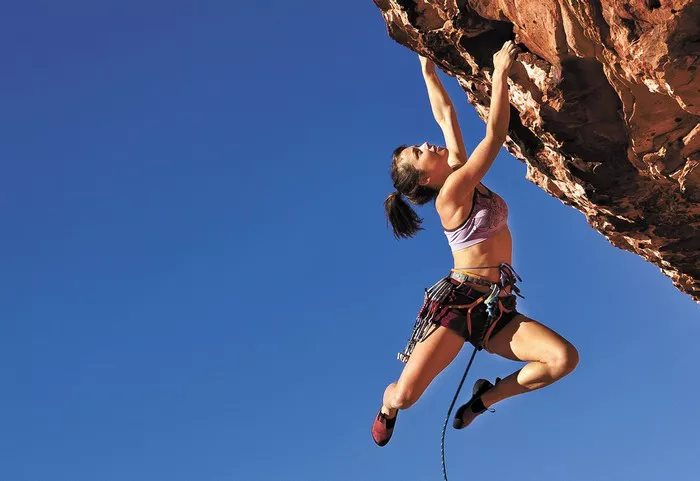In the world of rock climbing, there exists a form of ascent that epitomizes the purest connection between climber and cliff: free climbing. This discipline, characterized by its reliance on physical strength, technique, and mental focus, stands apart from other climbing styles due to its commitment to using only natural holds and features of the rock for upward progress. As we delve into the depths of free climbing, we uncover not just a sport but a philosophy—a way of engaging with the vertical world that demands everything from those who practice it.
Defining Free Climbing
To understand free climbing fully, it’s essential to distinguish it from related climbing styles such as aid climbing and free soloing. Free climbing, in its strictest sense, refers to a climbing method where the climber ascends the rock using only their hands, feet, and body for upward progression. The climber may use equipment such as ropes and protection solely for safety, not for aiding their ascent. This means that the climber is relying entirely on their physical and technical abilities to make upward progress, using the natural features of the rock—cracks, edges, and pockets—as holds.
Contrast this with aid climbing, where climbers use gear (such as ladders, hooks, and mechanical ascenders) to assist their progress, or free soloing, where climbers ascend without any safety equipment whatsoever. Free climbing occupies a unique middle ground—it celebrates the athleticism and skill of the climber while respecting the inherent challenges of the rock face.
The Skills and Techniques of Free Climbing
Success in free climbing is built upon a foundation of physical prowess, mental fortitude, and technical skill. Climbers must possess exceptional finger strength, balance, and flexibility to navigate the often-tenuous holds encountered on vertical terrain. Moreover, mastering climbing techniques such as smearing, edging, jamming, and stemming is crucial for efficient and controlled movement on the rock.
One of the key aspects of free climbing is the use of protective gear solely for safety, not for aiding progress. Climbers employ ropes, harnesses, and anchoring devices to arrest potential falls, thus mitigating the risks inherent in the sport. This separation of safety and aid distinguishes free climbing from aid climbing, underscoring its commitment to the purity of movement and challenge.
The Mental Game: Focus, Commitment, and Risk Management
Beyond physical prowess, free climbing demands exceptional mental discipline. Climbers must maintain unwavering focus while navigating intricate sequences of movements high above the ground. Each decision—each handhold, each foothold—is a calculated risk. The ability to manage fear and doubt is paramount; hesitation can spell disaster on a precarious route.
Moreover, successful free climbers must possess a deep understanding of risk management. They must assess the terrain, anticipate potential hazards, and make split-second decisions to mitigate danger. This acute awareness of one’s capabilities and limitations is crucial in a sport where the consequences of error can be severe.
The Evolution of Free Climbing
Free climbing has undergone significant evolution over the decades. What was once considered the pinnacle of difficulty is now surpassed regularly as climbers continuously push the boundaries of the sport. Advances in training techniques, equipment, and climbing ethics have fueled this progression.
The introduction of indoor climbing gyms has provided climbers with controlled environments to hone their skills and build strength year-round. Additionally, improvements in climbing shoe design and material technology have enhanced climbers’ abilities to edge on tiny features and smear on smooth surfaces, further enabling the pursuit of difficult routes.
Ethics and Environmental Considerations
Integral to free climbing is a commitment to ethical climbing practices and environmental stewardship. Leave No Trace principles are paramount, advocating for minimal impact on natural landscapes. Climbers are encouraged to stay on designated trails, minimize chalk use, and avoid altering the rock face.
Moreover, respecting climbing ethics involves adhering to route-specific guidelines, including the use of appropriate protection and refraining from altering the rock to create new holds. This dedication to responsible climbing ensures the preservation of climbing areas for future generations of enthusiasts.
The Thrill of the Climb
For those who immerse themselves in the world of free climbing, the rewards are manifold. The sense of accomplishment that accompanies topping out a challenging route is unparalleled. Each climb is a journey of self-discovery, revealing strengths and weaknesses both physical and mental. The freedom experienced on the rock transcends the mundane—a liberation from the constraints of gravity and doubt.
Conclusion
Ultimately, free climbing is more than a sport; it’s a way of life—a pursuit of personal excellence, resilience, and adventure. As climbers continue to explore new horizons and push the limits of what is possible, the essence of free climbing endures: the unwavering connection between human and stone, the triumph of the indomitable spirit against vertical odds.

